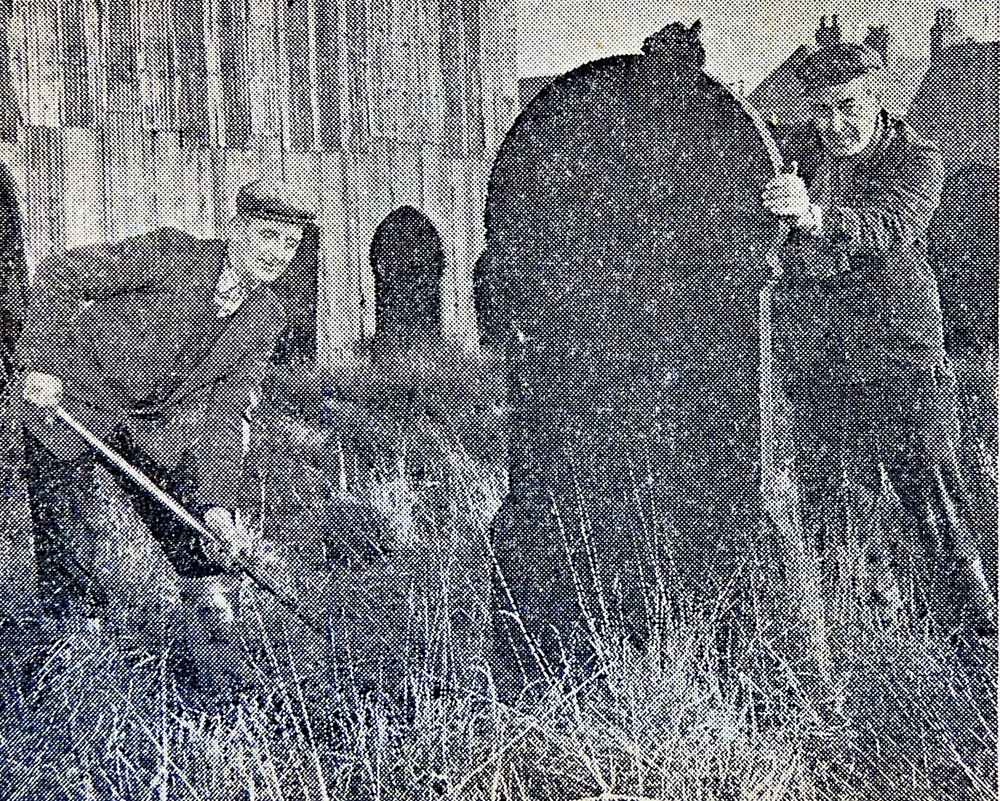So you’ve reached the grave, the grave doors are there and erected. You’ve got your three tools: spade, grafter and shaper. The first thing you need to do is to see how deep the grave you have to dig is to be and whether it is a new one or a you are re-opening one.
Deep
The grave slip will tell you how deep you will dig. The deepest grave that was available after WW2 in municipal cemeteries was for 4 adults. This would have been 8 foot 6 inches deep. 3 adults was for 7 foot. 2 adults was for 5 foot 6 inches and one adult would be interred at a depth of 4 foot 6 inches. Obviously if the grave is a re-opener you will know how deep you need to go once you hit the last coffin that was buried there.
If the grave is a new one you will measure the grave out and begin to dig. We all had different ways to approach this task. Mine was to cut out a shape in the turf, some 2 inches wider than the measurement I had been given, and begin the dig. Again, an issue that would need to be taken into account was the weather, trees, and the nature of the plot where you were digging.
Wet
If the weather was very wet and the plot you were on was a wet one. (by that I mean that it was poorly drained and retained water) If both of these factors were evident then you would need to shape the grave so that it could accommodate shoring boards. In essence then you would have a shape similar to a wedge. Wider at the head of the grave.
This is the shape you would dig until you reached about 3 foot. By this time you have an idea of the ground and whether it could cave- in on you. To stop that you would place the shoring boards at the 3 foot level. One on either side. they were usually a standard 6 or 7 foot board, 2 inches wide. This is why you would have started the dig 2 inches wider than the measurements you were given that morning.
Strut
There were a good supply of struts in the store. You would have picked up about 6 when you went to pick up your shoring boards and a hammer. Placing the shoring boards in the grave at the level you’ve reached you would hammer the struts in, effectively tightening the boards against the grave walls until the boards would not move. In this way you had a good chance that the soil would not move when you dug any deeper.
Once the boards were in place you carried on digging, keeping a constant eye on the numerous cracks in the clay that were appearing, occasionally putting your ear to the walls of the grave to listen for water running. Now, after placing the shoring in, was the time when you began digging a coffin shape to the measurements you were given. ( after adding 2 inches for the coffin handles of course. No one likes a coffin that sticks half way down).
Stager
Once you reached 5 foot 6 inches you were allowed a stager. This was another worker to help throw the soil from the staging board over the grave on to the soil heap. Because by this time the soil heap was quite high and you were quite deep. So now you threw the soil up to the other side of where you had been throwing it and the stager scooped it up and threw over you on the soil heap.
A good stager was great. Firstly, they could throw the soil over without most of it landing on your head. Secondly they could keep an eye out on the grave walls for cracks and buckling. You had a stager for any grave deeper than 5 foot 6 inches.
After a while you gained the knowledge of how deep you were without recourse to a tape measure. A 7 footer I could stand at the bottom and touch the top of the grave. And 8 foot 6″ was an arms length again. Also the soil changed. It was usually clay for the first 5 foot, after that it changed to a rather nice sandy soil that kept together, after 8 foot it turned to a bluey clay that wan’t sticky.
Tea
Once you’d reached the required depth you shored up the part of the grave below the previous shoring with some more boards. And then you were allowed a 15 minute break for a cup of tea. This is what happened when everything went well. There were days when they didn’t but that’s for another time.
‘Gravedigger’ by Pete Lowden

Pete Lowden is a member of the Friends of Hull General Cemetery committee which is committed to reclaiming the cemetery and returning it back to a community resource.

